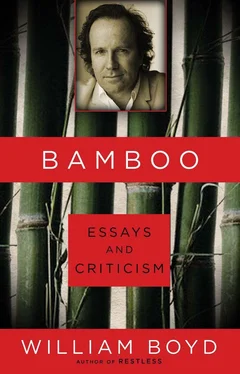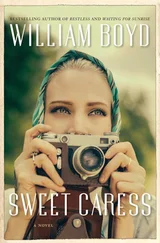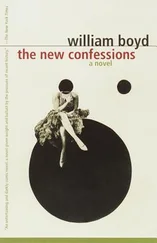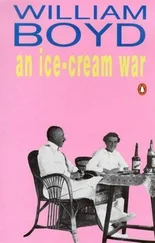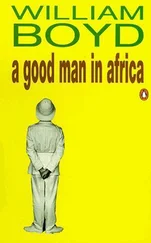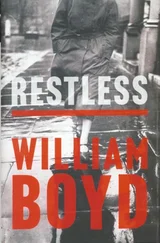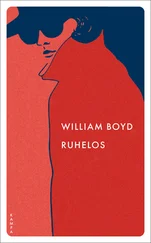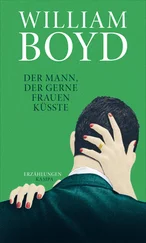During the next few years the two men were at their closest, and it was inevitable that a certain amount of cross-fertilization would emerge. On the vexed question of who influenced whom Bacon is commonly granted the upper hand, but attempts to document the exchange precisely are fruitless. Baconian elements appear in some of Sutherland’s works; but there are also elements of Sutherland in some of Bacon’s canvases. Indeed, one could mount a very convincing argument that such major Sutherland paintings as Gorse on Sea Wall , 1939, or Green Tree Form , 1940, completely prefigure the classic Baconian composition — a twisted, tortured, organic form set more or less centrally against bold opaque panels of colour. But such point-scoring is redundant: it is in their dissimilarities that our interest lies.
The list of oppositions is fascinating and extends to their personalities. Sutherland charming and well mannered; Bacon the extrovert roué. Sutherland the devoted husband; Bacon the promiscuous homosexual. The paramount place of line in Sutherland’s work; with Bacon the plasticity of the painted surface. Sutherland making study after study, laboriously squaring up and striving for perfection; Bacon relying on the adventitious moment, destroying everything that hadn’t worked. Sutherland face to face with landscape and nature; Bacon confined to interiors. Sutherland’s passionate response to the natural world in all its forms; Bacon’s brutal obsession with the human condition. Sutherland the master etcher, the portrait painter, technically accomplished; Bacon who claimed “I know nothing about technique.” And so on.
I am reminded here of Archilocus’ ancient and somewhat baffling adage: “The fox knows many things — the hedgehog knows one big thing.” If Bacon is the hedgehog of twentieth-century British painting — and any survey of his oeuvre will illustrate the “one big thing” he knew, the relentless single-mindedness of his art, the one furrow he ploughed almost without deviation from the 1944 Figures at the Base of a Crucifixion —then Graham Sutherland is the fox. And one’s response to both these artists will, in the end, be determined by one’s affiliation to either the “Fox” school of painting or the “Hedgehog,” if I can extend the metaphor. For those who judge that all great painting springs from a fundamental mastery of line, that it is the absolute bedrock upon which all other forms of expression, however free, rest, then Sutherland, the “Fox,” will claim their adherence. For those who like their emotions raw and unadulterated, then the “Hedgehog” Bacon will win the day. From my point of view, I find Sutherland’s achievement the more impressive. Much as I admire Bacon’s single-mindedness, much as I acknowledge the sheer heft of his presence in the history of twentieth-century British art and respond to the visceral force of his canvases, I find the paucity of graphic skill a weakness at the centre of his work. A worry.
Bacon liked to sneer at Picasso and Matisse — the great modern masters of the line — and their talent for “decoration” as he put it. So too did he dismiss Sutherland as their friendship cooled in the fifties and the sixties and as his own stature grew. He likened Sutherland’s great portraits to “ Time magazine covers,” a peevish slur in any event, but one that might have more weight if there were any evidence that Bacon himself was his equal, or even near equal, when it came to sheer ability to draw. All artists set out to create a taste by which they may be appreciated, and Bacon’s denigration of those artists who possess this immense graphic gift is highly revealing. Sutherland, who was blessed in this way, was a more generous spirit towards his former friend. But then foxes can always afford to be kind to hedgehogs.
1993
A novelist, who had done his time in the screenplay salt mines of Hollywood, was asked once to define the difference between novel writing and script writing. The answer came in the form of this useful analogy: writing a novel is like swimming in the sea; writing a screenplay is like swimming in a swimming pool. The comparison is worth bearing in mind whenever one has to distinguish between radically different forms of activity within the same art form. Different satisfactions are in play, different resources are drawn upon and, it has to be said, one activity is going to be more rewarding than the other.
The analogy is particularly germane, it seems to me, when one comes to analysing the respective merits of figurative and non-figurative painting. I want to concentrate, as far as the last category is concerned, on what one might call pure abstract art, namely one where all attempt at representation has been eschewed, where, in the terms of one definition, “neither the work itself, or any of its parts represents nor symbolises objects in the visible world.”
It is worth raking over the coals of this debate as one of the great exemplars of this form of abstraction has just had a major exhibition in London. Franz Kline and the loosely associated members of the New York School (Jackson Pollock, Mark Rothko, Robert Motherwell, William Baziotes, Clifford Still, Barnett Newman and others) initiated what one might call the second great wave of abstract painting in the late 1940s and 1950s (I am taking the work of Kandinsky and the Blaue Reiter group to be the groundbreakers in pure abstract painting, a trend that culminated in Mondrian’s primary-coloured grid paintings in the late 1930s). However, nothing in this corner of European modernism matched the brouhaha that erupted in New York with the advent of Abstract Expressionism. “The death of figuration” was loudly bruited about by both artists and critics, such was the influence and excitement generated by this group of painters.
Today, contemplating the pronouncements issued at the time, and the extravagant claims made for the artists themselves, a curious, not to say incredulous, distancing takes place. Can people really have believed that the arrival on the scene of Kline, Pollock, de Kooning, Rothko, Mother-well and the others signalled a watershed of such magnitude in the history of art? What does it say, half a century on from those days, about the kinds of critical judgement on offer? Can we really blame it all on Clement Greenberg?
As the twentieth century draws to its close, one of the most intriguing intellectual exercises will be the retrospective reassessment of “Modernism” (by which I mean that generation of revolution against formal traditions in all the arts that started, one might claim, with Schoenberg’s D minor quartet in 1905 and Picasso’s Les Desmoiselles d’Avignon in 1907, and ended, let’s say, with the publication of Finnegans Wake and the outbreak of World War II in 1939). As time relentlessly intercedes between then and now, it will be all the easier to chart Modernism’s rise and fall, and analyse its application and transmogrification in the art forms of this particular 100 years. And it will be seen — it is already evident — that the archetypal, fundamental characteristics of the seven arts have absorbed and adapted themselves both to the serious currents of theory and innovation and also to the countless bouleversements of taste and wilful modishness that have swirled busily around them. Like mountains they are eroded somewhat, somewhat altered here and there, some cliff faces are more seamed and haggard, in some places the tree line has advanced or receded, but their elemental character remains the same. They have not, to extend the metaphor, suddenly become ox-bow lakes, or salt flats: for all the upheavals of their recent history they resolutely remain mountains. The novel, for example, has taken on board the lessons of Proust and Joyce, has filleted what little it likes from Virginia Woolf and decided to spit out much of what, say, B. S. Johnson and Alain Robbe-Grillet served up. Similarly with the theatre and the cinema — our diet is not pure Beckett and Brecht or Jean-Luc Godard and Ozu. Dance and music, too, have recognized where the culs-de-sac lie and have changed and reflected the upheavals in taste and aesthetics that have come and gone. One would like to say the same about painting and sculpture, and to a significant degree that is the case: the necessary lessons of the Modernist generation have been learned and have been exploited by most of our great artists. But to another, more worrying, extent it often seems to me that many artists — and critics and curators and dealers — still behave as if the Modernist iconoclasms of the 1920s and 1930s are as valid as they ever were. Here and there in the art world people still seem possessed of the desire to épater les bourgeois (as if they haven’t been thoroughly routed), to be outrageous, to break the mould, to “push the envelope,” as they say in Hollywood, as if this were something new, as if it hadn’t already been done for us before, many many times. In some areas Art at the end of the twentieth century — and this is not meant to be glib — seems the only art form that has not learned the lessons that the beginning of the century provided. It has not outgrown Modernism. It has not, in other words, grown up.
Читать дальше
